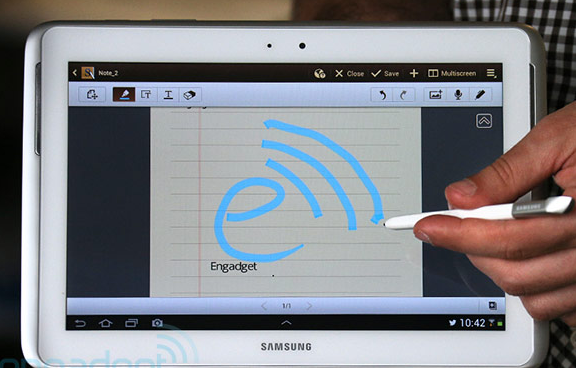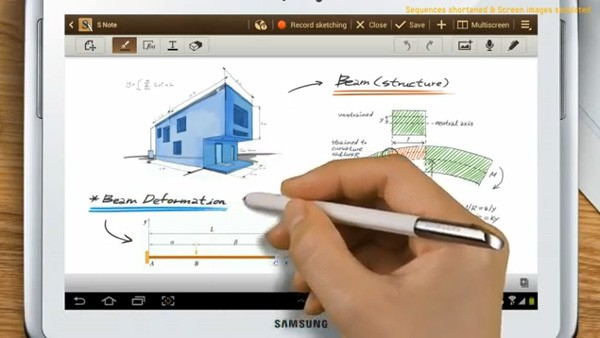The Note is not just pocket sized, the range
now has a ten-inch version too

Samsung
galaxy note 10.1
Side-by-side
Some apps are capable of being used
side-by-side. two at a time. The selection is limited, but it’s a nice idea
Fast and capable
With a quad-core processor and 2GB of RAM,
this tablet seems to fly along
Stylus
A stylus sits in a housing on the chassis
ready to be popped out and used
Samsung’s Galaxy Note proved such a
surprise hit that the company has not only produced a follow-up handset but
also a spin-off in the form of a full-sized tablet. As a Note it does include a
pen for scribbling on the screen, but other than that, it is not really a
companion device to its smaller ‘phablet’ brother. While that is unique, the
Note 10.1 has plenty of competition, not least from Samsung itself with the
similarly specced (and much cheaper) Galaxy Tab 2. Has the company gone crazy
by splitting its own market in this way, or is it ensuring that it has devices
for every need?
Well, that rather depends on whether the
Galaxy Note meets a need. We aren't so sure about that. For all the goodness of
the pen-based input it is still limited, and we aren’t sure we’d actually use
it a great deal after the initial excitement. Others will disagree, we’re sure.
The stylus sits in a housing on the chassis
and you can use it all the time. Tapping icons with its nib has the same effect
as patting them with a fingertip, and you can sweep with the stylus too, for
example, on the unlock screen.

The
stylus sits in housing on the chassis and you can use it all the time
Not all apps support the stylus, though. A
sidebar showing those that do appears when you extract the pen. The list is
small: S Note, S Planner, Crayon Physics, PS Touch and Polaris Office. These
variously let you make notes, manage your diary, play a physics-based game,
draw and edit images and create Office files. There’s handwriting recognition
in the Notes app. You’ll find other pen supporting apps for download, too.
It’s all very similar to the Galaxy Note
II, except that it runs a slightly older version of the software, including the
Ice Cream Sandwich operating system rather than Jelly Bean.
There are a couple of other goodies on
board. You can split-screen some apps, viewing two at the same time. But the
selection is small. Web browser, video player, Polaris Office, gallery, email
and S Note are the full set.
You can also take advantage of the same
pop-out video player that we saw on the Samsung Galaxy S III. In this larger
screen it is a much more interesting proposition.
Physically the Galaxy Note 10.1 and Galaxy
Tab 2 10.1 are very similar to look at. They share the same front-mounted
speaker grilles and silver outer frame. Samsung hasn’t worked really hard to
make the Galaxy Note 10.1 look very different. Build quality is reasonable but
there is a little flex in the backplate and its plastic might be prone to
scratching, so a case will be necessary.
The screen delivers 1,280 x 800 pixels
while others (eg the Transformer Pad Infinity from Asus) present 1,920 x 1,200,
while the much smaller screened Note II has 1,280 x 720 and is much crisper for
it. But it is bright and most definitely clear enough for everyday working.

The
core specifications are strong, with Android 4.0 driven by a 1.4GHz quad-core
processor and a very generous 2GB of RAM in support
The core specifications are strong, with
Android 4.0 driven by a 1.4GHz quad-core processor and a very generous 2GB of
RAM in support. That’s double the amount of RAM we've seen even in top-end
devices, and it must be part of the reason the Galaxy Note 10.1 seems to fly.
There is 16GB of storage, and a micro SD card for adding more. It’s irritating
that there’s no HDMI output-you need to use an optional extra adaptor for the
proprietary mains connector to get HDMI. And that connector also doubles as the
USB link. That will no doubt disappoint people who have standardised to USB,
though at least Samsung does provide the cable.
On the other hand Samsung includes an
infrared port and an app, Peel Smart Remote, which lets you control IR devices
such as yourTV. It’s an old fashioned idea being given a new lease of life.
Just as interesting as its own features is
how the Samsung Galaxy Note 10.1 compares to the Galaxy Tab 210.1. We’ve noted
the design similarities.
The 16GB non-3G version can currently be
found online for around $600, while the non-3G Galaxy Tab II is marketed at
around $460.
The Note 10.1 is Samsung’s best tablet yet,
and a better product than the Tab 2, but with a not inconsiderable price
difference it’s up to you to compare specs and consider whether you really need
a pen with your tablet.
Stylus
apps
A suite of apps is included specially for
use with the stylus, and you can download more
Pop-out player
There’s a pop-out video player that you can
always keep on top and resize as needed
Battery life
You ought to get through a weekend of
mid-level use
Performance
Positively zips along - this is a fast and
responsive tablet
Design
As you would expect, nice design, solid
build, pen well thought out
Features
Plenty going on under the hood with some
very nice software tweaks
Value for money
You pay a premium price for the stylus
support - do you really need it?
Verdict
Stylus support is rare, so this tablet
automatically separates itself from competition. It’s nicely implemented too
|
Details
·
Price: $625
·
More information : www.samsung.com
Technical specs
·
Operating system: Android 4.0
·
Processor: 1.4GHz quad-core
·
Memory: 16GB storage
·
Dimensions: 257.8 x 175.3 x 8.9 mm
·
Weight: 580g
·
Display size: 10.1-inch
·
Display resolution: 1,280 x 800 pixels
·
Expansion slot : micro SD
|